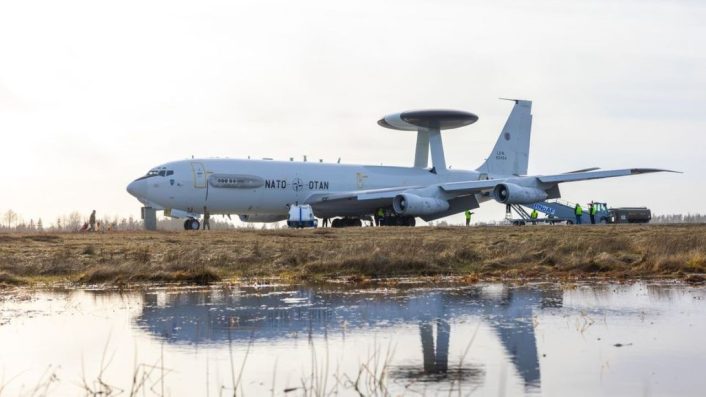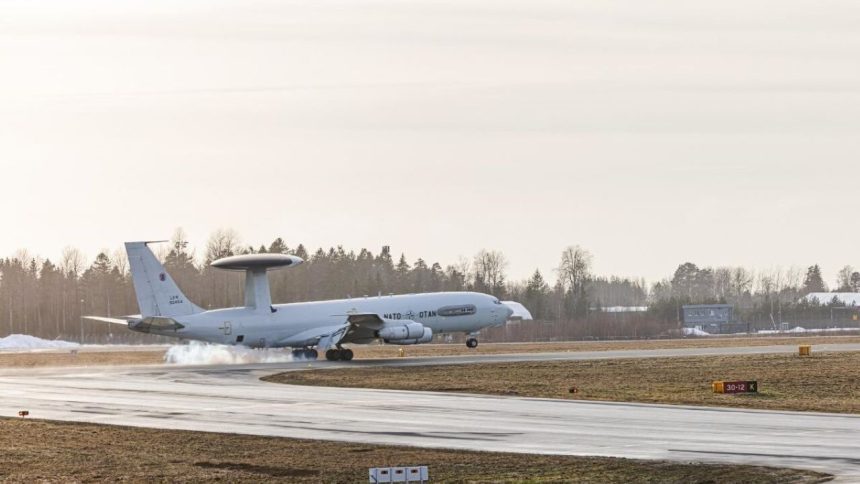The AWACS, described as NATO’s ‘eyes in the skies’, usually employed Ørland as forward base, however this time it was decided to deploy the aircraft to Rygge, with at least two E-3s already operating from there.
The Norwegian military announced last week that its Rygge air base, in the southern part of the country, will begin frequently hosting NATO’s E-3 Sentry AWACS (Airborne Warning and Control System) aircraft. This is owing to the unavailability of the runway at Ørland in western Norway, which led to Rygge being chosen, the statement from the Norwegian Armed Forces said on Aug. 22, 2024.
Interestingly, the notice came a day prior to the threat alert at the NATO air base in Geilenkirchen, in far-western Germany, on Aug. 23, which saw personnel being evacuated until the alert was deactivated. The base is home to the NAEW&CF (NATO Airborne Early Warning and Control Force) E-3A Component.
Subsequent reports by German media said that the alert was owing to indications of “preparatory actions for a likely Russian act of sabotage,” although a NATO spokesperson later denied. “The word Russia was never mentioned,” said the spokesperson to Reuters. “We talked about a threat caused by drones.”
E-3s from the NAEW&CF had already operated from Rygge during the Nordic Response 2024 exercise, held from Feb. 26 to Mar. 15. Flight tracking data three days after the announcement, on Aug. 25, also showed an E-3 Sentry (callsign NATO40) operating between Rygge and Denmark over the North Sea. Again on Aug. 28 and Aug. 29, two E-3s (callsigns NATO01 and NATO06) were circling the length from northern Norway over the Norwegian Sea to northern Germany in two separate routes, operating from Rygge.
#NATO 2x E-3A sentry awacs seen on the flight radar this afternoon, aircraft circling over the north of germany and norwegian sea, departures and return at oslo. #NATO01 #NATO06 pic.twitter.com/AUSBdLxk50
— wip. (@alternativewip) August 28, 2024
Nordic Response was the name given to the Norwegian military’s annual Cold Response series of maneuvers, after it was expanded to include Finland and Sweden, following their accession to NATO. Nordic Response itself was a part of the broader Steadfast Defender exercise.
‘E-3s to become a Common Sight at Rygge’
According to the statement by the Norwegian Armed Forces, “Several aircraft of the type E-3A AWACS will operate from Rygge air station in the coming weeks.” Usually, the AWACS are “periodically stationed at Ørland air station, as a forward base for NATO.” The decision to relocate them to Rygge is owing to unavailability of the runway at Ørland for AWACS operations, said the press release without providing details.
“From their main base in Germany, the E-3 aircraft “are regularly seen over and in Norway for shorter missions, where they exercise and train together with allied and Norwegian military forces.” Ørland Air Station meanwhile is the RNoAF’s (Royal Norwegian Air Force) main F-35 base, which is expected to receive all its Lightning IIs by 2025.

“Our role is to facilitate and support AWACS operations from Rygge air station. We are well prepared for the mission, and look forward to receiving both aircraft, personnel and equipment,” said Colonel Thomas Orud Harlem, commander of 134 Air Wing, in the press release. The Wing has a helicopter unit that operates the Bell 412, besides being home to Air Force Training and Air Force Operations Inspectorates.
Nordic Response 2024
As mentioned before, NATO E-3As last operated from Rygge during the Nordic Response exercise between February and March this year. NATO said that at Rygge, during the drills, the participating countries operated two E-3A AWACS planes.
“The E-3A aircraft is often referred to as NATO’s ‘eyes in the skies’,” noted NATO’s press release. “This is due to its capability to detect air and sea movements hundreds of kilometers away. This data is shared with NATO commanders to provide them with a shared understanding of activities that take place in areas of particular concern.”
This year’s expanded version of the exercise saw the participation of over 20,000 soldiers from 13 allied nations. Of these, approximately 10,000 exercised on land and were the most visible during the exercise. The participating countries included Belgium, Canada, Denmark, Finland, France, Germany, Italy, the Netherlands, Norway, Spain, Sweden, the United Kingdom, and the United States.
More than 100 fighter jets, transport aircraft, maritime surveillance aircraft, as well as allied CH-53 Super Stallion, EH-101 Merlin, AH-1 Cobra helicopters and V-22 Osprey tiltrotor participated. Nordic Response was also closely integrated with the British-led naval exercise Joint Warrior, which took place in the sea between Scotland, Norway, and Iceland in late February.
Swedish Air Force JAS 39 #Gripen fighters over northern #Norway as part of exercise #NordicResponse2024. 211 squadron ‘Akktu Stakki’. Photos: Flygvapnet F 21 pic.twitter.com/OQyuplfOLH
— Gripen News (@GripenNews) March 6, 2024
E-3 Sentry AWACS is NATO’s key asset
“The strategic role of the NATO Airborne Early Warning and Control Force cannot be overstated,” said Air Commodore Andrew Turk, NATO Airborne Early Warning and Control Force Chief of Staff and Deputy Commander. “We can showcase this in a large-scale, multi-domain scenario like Exercise Nordic Response 24, showing our determined ambition to dominate the airspace and defend the Alliance.”
The importance of such assets was also stated by Norway with the announcement of the deployment to Rygge. “The aircraft operates as a command and control unit in the air, has unique characteristics and can detect both sea, land and air movements from far away,” said the statement. “Together with other sources of information, they form a comprehensive aerial view for decision-makers.”
Nordic Response also came at a time when “for the first time, NATO is setting new defence plans into reality proving their executability and NATO’s warfighting transformation,” said an official statement. The transformation also includes the renewal of the AWACS fleet, which will be replaced by the newer E-7 Wedgetail.
Last year NATO decided to replace its fleet of 14 E-3A AWACS with six new E-7A, with the first one expected to be delivered by 2031. The Wedgetail will be part of the Alliance Future Surveillance and Control system of systems capability, which will also include space and maritime intelligence, surveillance and reconnaissance assets, along with the already operational RQ-4 Alliance Ground Surveillance.









